High Resolution Brillouin Sensing of Micro-Scale Structures
Abstract
:1. Introduction
2. Brillouin Sensing Principle
2.1. Backward Brillouin Scattering
2.2. Forward Brillouin Scattering
3. Distributed Brillouin Sensing Techniques
4. Correlation-Based Brillouin Sensing
5. Sensing of Micro-Scale Structures
5.1. Non-Distributed Backward Brillouin Measurement
5.2. Non-Distributed Forward Brillouin Measurement
5.3. Distributed Backward Brillouin Measurement
6. Conclusions and Outlook
Funding
Conflicts of Interest
References
- Kang, M.S.; Nazarkin, A.; Brenn, A.; Russell, P.S.J. Tightly trapped acoustic phonons in photonic crystal fibres as highly nonlinear artificial Raman oscillators. Nat. Phys. 2009, 5, 276–280. [Google Scholar] [CrossRef]
- Gattass, R.R.; Svacha, G.T.; Tong, L.; Mazur, E. Supercontinuum generation in submicrometer diameter silica fibres. Opt. Express 2006, 14, 9408. [Google Scholar] [CrossRef] [PubMed]
- Leon-Saval, S.G.; Birks, T.A.; Wadsworth, W.J.; Russell, P.S.J.; Mason, M.W. Supercontinuum generation in submicron fibre waveguides. Opt. Express 2004, 12, 2864. [Google Scholar] [CrossRef] [PubMed]
- Foster, M.A.; Turner, A.C.; Lipson, M.; Gaeta, A.L. Nonlinear optics in photonic nanowires. Opt. Express 2008, 16, 1300. [Google Scholar] [CrossRef] [PubMed]
- Espinola, R.L.; Dadap, J.I.; Osgood, R.M., Jr.; McNab, S.J.; Vlasov, Y.A. Raman amplification in ultrasmall silicon-on-insulator wire waveguides. Opt. Express 2004, 12, 3713. [Google Scholar] [CrossRef] [PubMed]
- Dulkeith, E.; Vlasov, Y.A.; Chen, X.; Panoiu, N.C.; Osgood, R.M. Self-phase-modulation in submicron silicon-on-insulator photonic wires. Opt. Express 2006, 14, 5524–5534. [Google Scholar] [CrossRef]
- Hsieh, I.W.; Chen, X.; Dadap, J.I.; Panoiu, N.C.; Osgood, R.M.; McNab, S.J.; Vlasov, Y.A. Ultrafast-pulse self-phase modulation and third-order dispersion in Si photonic wire-waveguides. Opt. Express 2006, 14, 12380–12387. [Google Scholar] [CrossRef]
- Foster, M.A.; Turner, A.C.; Sharping, J.E.; Schmidt, B.S.; Lipson, M.; Gaeta, A.L. Broad-band optical parametric gain on a silicon photonic chip. Nature 2006, 441, 960–963. [Google Scholar] [CrossRef]
- Levy, J.S.; Gondarenko, A.; Foster, M.A.; Turner-Foster, A.C.; Gaeta, A.L.; Lipson, M. CMOS-compatible multiple-wavelength oscillator for on-chip optical interconnects. Nat. Photonics 2010, 4, 37–40. [Google Scholar] [CrossRef]
- Florez, O.; Jarschel, P.F.; Espinel, Y.A.V.; Cordeiro, C.M.B.; Mayer Alegre, T.P.; Wiederhecker, G.S.; Dainese, P. Brillouin scattering self-cancellation. Nat. Commun. 2016, 7, 11759. [Google Scholar] [CrossRef] [Green Version]
- Beugnot, J.C.; Lebrun, S.; Pauliat, G.; Maillotte, H.; Laude, V.; Sylvestre, T. Brillouin light scattering from surface acoustic waves in a subwavelength-diameter optical fibre. Nat. Commun. 2014, 5, 5242. [Google Scholar] [CrossRef] [PubMed] [Green Version]
- Tchahame, J.C.; Beugnot, J.C.; Huy, K.P.; Laude, V.; Kudlinski, A.; Sylvestre, T. Surface Brillouin scattering in photonic crystal fibres. Opt. Lett. 2016, 41, 3269. [Google Scholar] [CrossRef] [PubMed]
- Pant, R.; Poulton, C.G.; Choi, D.Y.; Mcfarlane, H.; Hile, S.; Li, E.; Thevenaz, L.; Luther-Davies, B.; Madden, S.J.; Eggleton, B.J. On-chip stimulated Brillouin scattering. Opt. Express 2011, 19, 8285. [Google Scholar] [CrossRef] [PubMed] [Green Version]
- Van Laer, R.; Kuyken, B.; Van Thourhout, D.; Baets, R. Interaction between light and highly confined hypersound in a silicon photonic nanowire. Nat. Photonics 2015, 9, 199–203. [Google Scholar] [CrossRef] [Green Version]
- Kittlaus, E.A.; Shin, H.; Rakich, P.T. Large Brillouin amplification in silicon. Nat. Photonics 2016, 10, 463–467. [Google Scholar] [CrossRef] [Green Version]
- Lu, P.; Men, L.; Sooley, K.; Chen, Q. Tapered fibre Mach–Zehnder interferometer for simultaneous measurement of refractive index and temperature. Appl. Phys. Lett. 2009, 94, 131110. [Google Scholar] [CrossRef]
- Ritari, T.; Tuominen, J.; Ludvigsen, H. Gas sensing using air-guiding photonic bandgap fibres. Opt. Express 2004, 12, 4080. [Google Scholar] [CrossRef]
- Wu, D.K.C.; Kuhlmey, B.T.; Eggleton, B.J. Ultrasensitive photonic crystal fibre refractive index sensor. Opt. Lett. 2009, 34, 322. [Google Scholar] [CrossRef]
- Dicaire, I.; De Rossi, A.; Combrié, S.; Thévenaz, L. Probing molecular absorption under slow-light propagation using a photonic crystal waveguide. Opt. Lett. 2012, 37, 4934. [Google Scholar] [CrossRef] [Green Version]
- Marpaung, D.; Morrison, B.; Pagani, M.; Pant, R.; Choi, D.Y.; Luther-Davies, B.; Madden, S.J.; Eggleton, B.J. Low-power, chip-based stimulated Brillouin scattering microwave photonic filter with ultrahigh selectivity. Optica 2015, 2, 76. [Google Scholar] [CrossRef] [Green Version]
- Sancho, J.; Primerov, N.; Chin, S.; Antman, Y.; Zadok, A.; Sales, S.; Thévenaz, L. Tunable and reconfigurable multi-tap microwave photonic filter based on dynamic Brillouin gratings in fibres. Opt. Express 2012, 20, 6157. [Google Scholar] [CrossRef] [PubMed]
- Li, J.; Lee, H.; Vahala, K.J. Microwave synthesizer using an on-chip Brillouin oscillator. Nat. Commun. 2013, 4, 2097. [Google Scholar] [CrossRef] [PubMed]
- Merklein, M.; Stiller, B.; Kabakova, I.V.; Mutugala, U.S.; Vu, K.; Madden, S.J.; Eggleton, B.J.; Slavík, R. Widely tunable, low phase noise microwave source based on a photonic chip. Opt. Lett. 2016, 41, 4633. [Google Scholar] [CrossRef] [PubMed] [Green Version]
- Loh, W.; Green, A.A.S.; Baynes, F.N.; Cole, D.C.; Quinlan, F.J.; Lee, H.; Vahala, K.J.; Papp, S.B.; Diddams, S.A. Dual-microcavity narrow-linewidth Brillouin laser. Optica 2015, 2, 225. [Google Scholar] [CrossRef] [Green Version]
- Lee, H.; Chen, T.; Li, J.; Yang, K.Y.; Jeon, S.; Painter, O.; Vahala, K.J. Chemically etched ultrahigh-Q wedge-resonator on a silicon chip. Nat. Photonics 2012, 6, 369–373. [Google Scholar] [CrossRef] [Green Version]
- Kabakova, I.V.; Pant, R.; Choi, D.y.; Debbarma, S.; Luther-Davies, B.; Madden, S.J.; Eggleton, B.J. Narrow linewidth Brillouin laser based on chalcogenide photonic chip. Opt. Lett. 2013, 38, 3208. [Google Scholar] [CrossRef] [Green Version]
- Morrison, B.; Casas-Bedoya, A.; Ren, G.; Vu, K.; Liu, Y.; Zarifi, A.; Nguyen, T.G.; Choi, D.Y.; Marpaung, D.; Madden, S.J.; et al. Compact Brillouin devices through hybrid integration on silicon. Optica 2017, 4, 847. [Google Scholar] [CrossRef] [Green Version]
- Otterstrom, N.T.; Behunin, R.O.; Kittlaus, E.A.; Wang, Z.; Rakich, P.T. A silicon Brillouin laser. Science 2018, 360, 1113–1116. [Google Scholar] [CrossRef]
- Büttner, T.F.S.; Merklein, M.; Kabakova, I.V.; Hudson, D.D.; Choi, D.Y.; Luther-Davies, B.; Madden, S.J.; Eggleton, B.J. Phase-locked, chip-based, cascaded stimulated Brillouin scattering. Optica 2014, 1, 311. [Google Scholar] [CrossRef]
- Dong, C.H.; Shen, Z.; Zou, C.L.; Zhang, Y.L.; Fu, W.; Guo, G.C. Brillouin-scattering-induced transparency and non-reciprocal light storage. Nat. Commun. 2015, 6, 6193. [Google Scholar] [CrossRef] [Green Version]
- Merklein, M.; Stiller, B.; Vu, K.; Madden, S.J.; Eggleton, B.J. A chip-integrated coherent photonic-phononic memory. Nat. Commun. 2017, 8, 574. [Google Scholar] [CrossRef] [PubMed] [Green Version]
- Qiu, W.; Rakich, P.T.; Shin, H.; Dong, H.; Soljačić, M.; Wang, Z. Stimulated Brillouin scattering in nanoscale silicon step-index waveguides: A general framework of selection rules and calculating SBS gain. Opt. Express 2013, 21, 31402. [Google Scholar] [CrossRef] [PubMed]
- Wolff, C.; Steel, M.J.; Eggleton, B.J.; Poulton, C.G. Stimulated Brillouin scattering in integrated photonic waveguides: Forces, scattering mechanisms, and coupled-mode analysis. Phys. Rev. A 2015, 92, 013836. [Google Scholar] [CrossRef]
- Poulton, C.G.; Pant, R.; Eggleton, B.J. Acoustic confinement and stimulated Brillouin scattering in integrated optical waveguides. J. Opt. Soc. Am. B 2013, 30, 2657. [Google Scholar] [CrossRef] [Green Version]
- Barclay, P.; Srinivasan, K.; Painter, O. Evanescent coupling from optical fibre tapers to photonic crystal waveguides and resonators. In Proceedings of the IEEE Postconference Digest Quantum Electronics and Laser Science, Baltimore, MD, USA, 1–6 June 2003; Volume 88, p. 2. [Google Scholar] [CrossRef]
- Stiller, B.; Delqué, M.; Beugnot, J.C.; Lee, M.W.; Mélin, G.; Maillotte, H.; Laude, V.; Sylvestre, T. Frequency-selective excitation of guided acoustic modes in a photonic crystal fibre. Opt. Express 2011, 19, 7689. [Google Scholar] [CrossRef] [PubMed]
- Jarschel, P.F.; Magalhaes, L.S.; Aldaya, I.; Florez, O.; Dainese, P. Fiber taper diameter characterization using forward Brillouin scattering. Opt. Lett. 2018, 43, 995. [Google Scholar] [CrossRef] [PubMed]
- Stiller, B.; Foaleng, S.M.; Beugnot, J.C.; Lee, M.W.; Delqué, M.; Bouwmans, G.; Kudlinski, A.; Thévenaz, L.; Maillotte, H.; Sylvestre, T. Photonic crystal fibre mapping using Brillouin echoes distributed sensing. Opt. Express 2010, 18, 20136. [Google Scholar] [CrossRef]
- Kurashima, T.; Horiguchi, T.; Tateda, M. Distributed-temperature sensing using stimulated Brillouin scattering in optical silica fibres. Opt. Lett. 1990, 15, 1038. [Google Scholar] [CrossRef]
- Bao, X.; Webb, D.J.; Jackson, D.A. 32-km distributed temperature sensor based on Brillouin loss in an optical fibre. Opt. Lett. 1993, 18, 1561. [Google Scholar] [CrossRef]
- Niklès, M.; Thévenaz, L.; Robert, P.A. Simple distributed fibre sensor based on Brillouin gain spectrum analysis. Opt. Lett. 1996, 21, 758. [Google Scholar] [CrossRef]
- Fellay, A.; Thévenaz, L.; Facchini, M.; Niklès, M.; Robert, P. Distributed sensing using stimulated Brillouin scattering: Towards ultimate resolution. In Proceedings of the 12th International Conference on Optical Fiber Sensors, Williamsburg, VA, USA, 28–31 October 1997; OSA: Washington, DC, USA; Volume 16, p. OWD3. [Google Scholar]
- Hotate, K.; Hasegawa, T. Measurement of Brillouin Gain Spectrum Distribution along an Optical Fiber Using a Correlation-Based Technique—Proposal, Experiment and Simulation. IEICE Trans. Electron. 2000, E83, 405–412. [Google Scholar]
- Zadok, A.; Antman, Y.; Primerov, N.; Denisov, A.; Sancho, J.; Thevenaz, L. Random-access distributed fibre sensing. Laser Photonics Rev. 2012, 6, L1–L5. [Google Scholar] [CrossRef]
- Song, K.Y.; He, Z.; Hotate, K. Distributed strain measurement with millimeter-order spatial resolution based on Brillouin optical correlation domain analysis. Opt. Lett. 2006, 31, 2526. [Google Scholar] [CrossRef] [PubMed]
- Hotate, K.; Watanabe, R.; He, Z.; Kishi, M. Measurement of Brillouin frequency shift distribution in PLC by Brillouin optical correlation domain analysis. In Proceedings of the OFS2012 22nd International Conference on Optical Fiber Sensors, Beijing, China, 26 October 2012; Volume 8421. [Google Scholar]
- Cohen, R.; London, Y.; Antman, Y.; Zadok, A. Brillouin optical correlation domain analysis with 4 millimeter resolution based on amplified spontaneous emission. Opt. Express 2014, 22, 12070. [Google Scholar] [CrossRef] [PubMed]
- Zarifi, A.; Stiller, B.; Merklein, M.; Li, N.; Vu, K.; Choi, D.Y.; Ma, P.; Madden, S.J.; Eggleton, B.J. Highly localized distributed Brillouin scattering response in a photonic integrated circuit. APL Photonics 2018, 3, 036101. [Google Scholar] [CrossRef]
- Zarifi, A.; Stiller, B.; Merklein, M.; Liu, Y.; Morrison, B.; Casas-Bedoya, A.; Ren, G.; Nguyen, T.G.; Vu, K.; Choi, D.Y.; et al. Brillouin spectroscopy of a hybrid silicon-chalcogenide waveguide with geometrical variations. Opt. Lett. 2018, 43, 3493. [Google Scholar] [CrossRef] [PubMed]
- Chow, D.M.; Beugnot, J.C.; Godet, A.; Huy, K.P.; Soto, M.A.; Thévenaz, L. Local activation of surface and hybrid acoustic waves in optical microwires. Opt. Lett. 2018, 43, 1487. [Google Scholar] [CrossRef] [PubMed]
- Motil, A.; Bergman, A.; Tur, M. [INVITED] State of the art of Brillouin fibre-optic distributed sensing. Opt. Laser Technol. 2016, 78, 81–103. [Google Scholar] [CrossRef]
- Bao, X.; Chen, L. Recent Progress in Brillouin Scattering Based Fiber Sensors. Sensors 2011, 11, 4152–4187. [Google Scholar] [CrossRef] [PubMed] [Green Version]
- Thévenaz, L. Brillouin distributed time-domain sensing in optical fibres: State of the art and perspectives. Front. Optoelectron. China 2010, 3, 13–21. [Google Scholar] [CrossRef]
- Hotate, K. Fiber distributed Brillouin sensing with optical correlation domain techniques. Opt. Fiber Technol. 2013, 19, 700–719. [Google Scholar] [CrossRef]
- Bao, X.; Chen, L. Recent Progress in Distributed Fiber Optic Sensors. Sensors 2012, 12, 8601–8639. [Google Scholar] [CrossRef] [PubMed] [Green Version]
- Masoudi, A.; Newson, T. Contributed Review: Distributed optical fibre dynamic strain sensing. Rev. Sci. Instrum. 2016, 87, 011501. [Google Scholar] [CrossRef] [PubMed] [Green Version]
- Zou, W.; He, Z.; Hotate, K. Investigation of Strain- and Temperature-Dependences of Brillouin Frequency Shifts in GeO2-Doped Optical Fibers. J. Lightwave Technol. 2008, 26, 1854–1861. [Google Scholar] [CrossRef]
- Horiguchi, T.; Shimizu, K.; Kurashima, T.; Tateda, M.; Koyamada, Y. Development of a distributed sensing technique using Brillouin scattering. J. Lightwave Technol. 1995, 13, 1296–1302. [Google Scholar] [CrossRef]
- Nikles, M.; Thevenaz, L.; Robert, P. Brillouin gain spectrum characterization in single-mode optical fibres. J. Lightwave Technol. 1997, 15, 1842–1851. [Google Scholar] [CrossRef]
- Thévenaz, L. Monitoring of large structure using distributed Brillouin fibre sensing. In Proceedings of the 13th International Conference on Optical Fiber Sensors, Kyongju, Korea, 1 September 1999; Volume 374642, p. 145. [Google Scholar] [CrossRef]
- Li, Y.; Zhang, F.; Yoshino, T. Wide-range temperature dependence of Brillouin shift in a dispersion-shifted fibre and its annealing effect. J. Lightwave Technol. 2003, 21, 1663–1667. [Google Scholar] [CrossRef]
- Zou, L.; Bao, X.; Afshar, V.S.; Chen, L. Dependence of the Brillouin frequency shift on strain and temperature in a photonic crystal fibre. Opt. Lett. 2004, 29, 1485. [Google Scholar] [CrossRef] [PubMed]
- Shiraki, K.; Ohashi, M. Sound velocity measurement based on guided acoustic-wave Brillouin scattering. IEEE Photonics Technol. Lett. 1992, 4, 1177–1180. [Google Scholar] [CrossRef]
- Shelby, R.M.; Levenson, M.D.; Bayer, P.W. Guided acoustic-wave Brillouin scattering. Phys. Rev. B 1985, 31, 5244–5252. [Google Scholar] [CrossRef]
- Tanaka, Y.; Ogusu, K. Tensile-strain coefficient of resonance frequency of depolarized guided acoustic-wave Brillouin scattering. IEEE Photonics Technol. Lett. 1999, 11, 865–867. [Google Scholar] [CrossRef]
- Hayashi, N.; Suzuki, K.; Set, S.Y.; Yamashita, S. Temperature coefficient of sideband frequency produced by polarized guided acoustic-wave Brillouin scattering in highly nonlinear fibres. Appl. Phys. Express 2017, 10, 092501. [Google Scholar] [CrossRef]
- Carry, E.; Beugnot, J.C.; Stiller, B.; Lee, M.W.; Maillotte, H.; Sylvestre, T. Temperature coefficient of the high-frequency guided acoustic mode in a photonic crystal fibre. Appl. Opt. 2011, 50, 6543. [Google Scholar] [CrossRef] [PubMed]
- Antman, Y.; Clain, A.; London, Y.; Zadok, A. Optomechanical sensing of liquids outside standard fibres using forward stimulated Brillouin scattering. Optica 2016, 3, 510. [Google Scholar] [CrossRef]
- Bashan, G.; Diamandi, H.H.; London, Y.; Preter, E.; Zadok, A. Optomechanical time-domain reflectometry. Nat. Commun. 2018, 9, 2991. [Google Scholar] [CrossRef]
- Chow, D.M.; Yang, Z.; Soto, M.A.; Thévenaz, L. Distributed forward Brillouin sensor based on local light phase recovery. Nat. Commun. 2018, 9, 2990. [Google Scholar] [CrossRef]
- Rakich, P.T.; Reinke, C.; Camacho, R.; Davids, P.; Wang, Z. Giant Enhancement of Stimulated Brillouin Scattering in the Subwavelength Limit. Phys. Rev. X 2012, 2, 011008. [Google Scholar] [CrossRef]
- Horiguchi, T.; Tateda, M. Optical-fibre-attenuation investigation using stimulated Brillouin scattering between a pulse and a continuous wave. Opt. Lett. 1989, 14, 408. [Google Scholar] [CrossRef]
- Horiguchi, T.; Tateda, M. BOTDA-nondestructive measurement of single-mode optical fibre attenuation characteristics using Brillouin interaction: Theory. J. Lightwave Technol. 1989, 7, 1170–1176. [Google Scholar] [CrossRef]
- Brown, A.; Colpitts, B.; Brown, K. Distributed sensor based on dark-pulse Brillouin scattering. IEEE Photonics Technol. Lett. 2005, 17, 1501–1503. [Google Scholar] [CrossRef]
- Bao, X.; Brown, A.; DeMerchant, M.; Smith, J. Characterization of the Brillouin-loss spectrum of single-mode fibres by use of very short (<10-ns) pulses. Opt. Lett. 1999, 24, 510. [Google Scholar] [CrossRef] [PubMed]
- Zou, L.; Bao, X.; Wan, Y.; Chen, L. Coherent probe-pump-based Brillouin sensor for centimeter-crack detection. Opt. Lett. 2005, 30, 370. [Google Scholar] [CrossRef] [PubMed]
- Foaleng, S.M.; Tur, M.; Beugnot, J.C.; Thévenaz, L. High spatial and spectral resolution long-range sensing using Brillouin echoes. J. Lightwave Technol. 2010, 28, 2993–3003. [Google Scholar] [CrossRef]
- Beugnot, J.C.; Tur, M.; Mafang, S.F.; Thévenaz, L. Distributed Brillouin sensing with sub-meter spatial resolution: Modeling and processing. Opt. Express 2011, 19, 7381. [Google Scholar] [CrossRef] [PubMed]
- Soto, M.A.; Bolognini, G.; Di Pasquale, F. Analysis of pulse modulation format in coded BOTDA sensors. Opt. Express 2010, 18, 14878. [Google Scholar] [CrossRef] [Green Version]
- Brown, A.W.; Colpitts, B.G.; Brown, K. Dark-Pulse Brillouin Optical Time-Domain Sensor With 20-mm Spatial Resolution. J. Lightwave Technol. 2007, 25, 381–386. [Google Scholar] [CrossRef]
- Thévenaz, L.; Foaleng Mafang, S. Distributed fibre sensing using Brillouin echoes. Proc. SPIE 2008, 7004, 70043N. [Google Scholar] [CrossRef]
- Bao, Y.; Meng, W.; Chen, Y.; Chen, G.; Khayat, K.H. Measuring mortar shrinkage and cracking by pulse pre-pump Brillouin optical time domain analysis with a single optical fibre. Mater. Lett. 2015, 145, 344–346. [Google Scholar] [CrossRef]
- Kishida, K.; Li, C.H. Pulse Pre-Pump-BOTDA technology for new generation of distributed strain measuring system. In Structural Health Monitoring and Intelligent Infrastructure, Proceedings of the 2nd International Conference on Structural Health Monitoring of Intelligent Infrastructure, Shenzhen, China, 16–18 November 2005; CRC Press: Boca Raton, FL, USA, 2006; Volume 1, pp. 471–477. [Google Scholar]
- Bao, Y.; Chen, G. High-temperature measurement with Brillouin optical time domain analysis of an annealed fused-silica single-mode fibre. Opt. Lett. 2016, 41, 3177. [Google Scholar] [CrossRef]
- Bao, Y.; Chen, G. Temperature-dependent strain and temperature sensitivities of fused silica single mode fibre sensors with pulse pre-pump Brillouin optical time domain analysis. Meas. Sci. Technol. 2016, 27, 065101. [Google Scholar] [CrossRef]
- Bernini, R.; Minardo, A.; Zeni, L. Distributed Sensing at Centimeter-Scale Spatial Resolution by BOFDA: Measurements and Signal Processing. IEEE Photonics J. 2012, 4, 48–56. [Google Scholar] [CrossRef] [Green Version]
- Song, K.Y.; Zou, W.; He, Z.; Hotate, K. All-optical dynamic grating generation based on Brillouin scattering in polarization-maintaining fibre. Opt. Lett. 2008, 33, 926. [Google Scholar] [CrossRef] [PubMed]
- Chin, S.; Primerov, N.; Thevenaz, L. Sub-Centimeter Spatial Resolution in Distributed Fiber Sensing Based on Dynamic Brillouin Grating in Optical Fibers. IEEE Sens. J. 2012, 12, 189–194. [Google Scholar] [CrossRef] [Green Version]
- Hasegawa, T.; Hotate, K. Measurement of Brillouin gain spectrum distribution along an optical fibre by direct frequency modulation of a laser diode. Proc. SPIE 1999, 3860, 306–316. [Google Scholar] [CrossRef]
- Zhang, J.; Zhang, M.; Zhang, M.; Liu, Y.; Feng, C.; Wang, Y.; Wang, Y. Chaotic Brillouin optical correlation-domain analysis. Opt. Lett. 2018, 43, 1722. [Google Scholar] [CrossRef] [PubMed]
- Zhang, J.; Feng, C.; Zhang, M.; Liu, Y.; Wu, C.; Wang, Y. Brillouin optical correlation domain analysis based on chaotic laser with suppressed time delay signature. Opt. Express 2018, 26, 6962. [Google Scholar] [CrossRef]
- Song, K.Y.; Hotate, K. Enlargement of measurement range in a Brillouin optical correlation domain analysis system using double lock-in amplifiers and a single-sideband modulator. IEEE Photonics Technol. Lett. 2006, 18, 499–501. [Google Scholar] [CrossRef]
- Antman, Y.; Yaron, L.; Langer, T.; Tur, M.; Levanon, N.; Zadok, A. Experimental demonstration of localized Brillouin gratings with low off-peak reflectivity established by perfect Golomb codes. Opt. Lett. 2013, 38, 4701. [Google Scholar] [CrossRef]
- Elooz, D.; Antman, Y.; Levanon, N.; Zadok, A. High-resolution long-reach distributed Brillouin sensing based on combined time-domain and correlation-domain analysis. Opt. Express 2014, 22, 6453. [Google Scholar] [CrossRef]
- Hotate, K.H.; Rai, H.A.; Ong, K.Y.S. Range-Enlargement of Simplified Brillouin Optical Correlation Domain Analysis Based on a Temporal Gating Scheme. SICE J. Control Meas. Syst. Integr. 2008, 1, 271–274. [Google Scholar] [CrossRef] [Green Version]
- Denisov, A.; Soto, M.A.; Thévenaz, L. Time gated phase-correlation distributed Brillouin fibre sensor. Proc. SPIE 2013, 8794, 87943I. [Google Scholar] [CrossRef]
- Zarifi, A.; Stiller, B.; Merklein, M.; Liu, Y.; Morrison, B.; Casas-Bedoya, A.; Ren, G.; Nguyen, T.G.; Vu, K.; Choi, D.Y.; et al. On-chip correlation-based Brillouin sensing: Design, experiment and simulation. arXiv, 2018; arXiv:1809.07160. [Google Scholar]
- Jeong, J.H.; Lee, K.; Song, K.Y.; Jeong, J.M.; Lee, S.B. Differential measurement for Brillouin optical correlation domain analysis. Opt. Express 2012, 20, 11091. [Google Scholar] [CrossRef] [PubMed]
- Hotate, K.; He, Z. Synthesis of optical-coherence function and its applications in distributed and multiplexed optical sensing. J. Lightwave Technol. 2006, 24, 2541–2557. [Google Scholar] [CrossRef]
- Chow, D.; Tchahame Nougnihi, J.C.; Denisov, A.; Beugnot, J.C.; Sylvestre, T.; Li, L.; Ahmad, R.; Rochette, M.; Tow, K.H.; Soto, M.A.; et al. Mapping the Uniformity of Optical Microwires Using Phase-Correlation Brillouin Distributed Measurements. In Proceedings of the Frontiers in Optics 2015, San Jose, CA, USA, 18–22 October 2015; OSA: Washington, DC, USA, 2015; p. FW4F.4. [Google Scholar] [CrossRef] [Green Version]
- Hotate, K.; Abe, K.; Song, K.Y. Suppression of Signal Fluctuation in Brillouin Optical Correlation Domain Analysis System Using Polarization Diversity Scheme. IEEE Photonics Technol. Lett. 2006, 18, 2653–2655. [Google Scholar] [CrossRef]
- Dainese, P.; Russell, P.S.J.; Joly, N.; Knight, J.C.; Wiederhecker, G.S.; Fragnito, H.L.; Laude, V.; Khelif, A. Stimulated Brillouin scattering from multi-GHz-guided acoustic phonons in nanostructured photonic crystal fibres. Nat. Phys. 2006, 2, 388–392. [Google Scholar] [CrossRef]
- Godet, A.; Ndao, A.; Sylvestre, T.; Pecheur, V.; Lebrun, S.; Pauliat, G.; Beugnot, J.C.; Phan Huy, K. Brillouin spectroscopy of optical microfibres and nanofibres. Optica 2017, 4, 1232. [Google Scholar] [CrossRef]
- Beugnot, J.C.; Sylvestre, T.; Maillotte, H.; Mélin, G.; Laude, V. Guided acoustic wave Brillouin scattering in photonic crystal fibres. Opt. Lett. 2007, 32, 17. [Google Scholar] [CrossRef]
- Wolff, C.; Laer, R.V.; Steel, M.J.; Eggleton, B.J.; Poulton, C.G. Brillouin resonance broadening due to structural variations in nanoscale waveguides. New J. Phys. 2016, 18, 025006. [Google Scholar] [CrossRef] [Green Version]
- Beugnot, J.C.; Sylvestre, T.; Alasia, D.; Maillotte, H.; Laude, V.; Monteville, A.; Provino, L.; Traynor, N.; Mafang, S.F.; Thévenaz, L. Complete experimental characterization of stimulated Brillouin scattering in photonic crystal fibre. Opt. Express 2007, 15, 15517. [Google Scholar] [CrossRef]
- Kittlaus, E.A.; Otterstrom, N.T.; Kharel, P.; Gertler, S.; Rakich, P.T. Non-reciprocal interband Brillouin modulation. Nat. Photonics 2018, 12, 613–619. [Google Scholar] [CrossRef]
- Kittlaus, E.A.; Kharel, P.; Otterstrom, N.T.; Wang, Z.; Rakich, P.T. RF-Photonic Filters via On-Chip Photonic–Phononic Emit–Receive Operations. J. Lightwave Technol. 2018, 36, 2803–2809. [Google Scholar] [CrossRef]
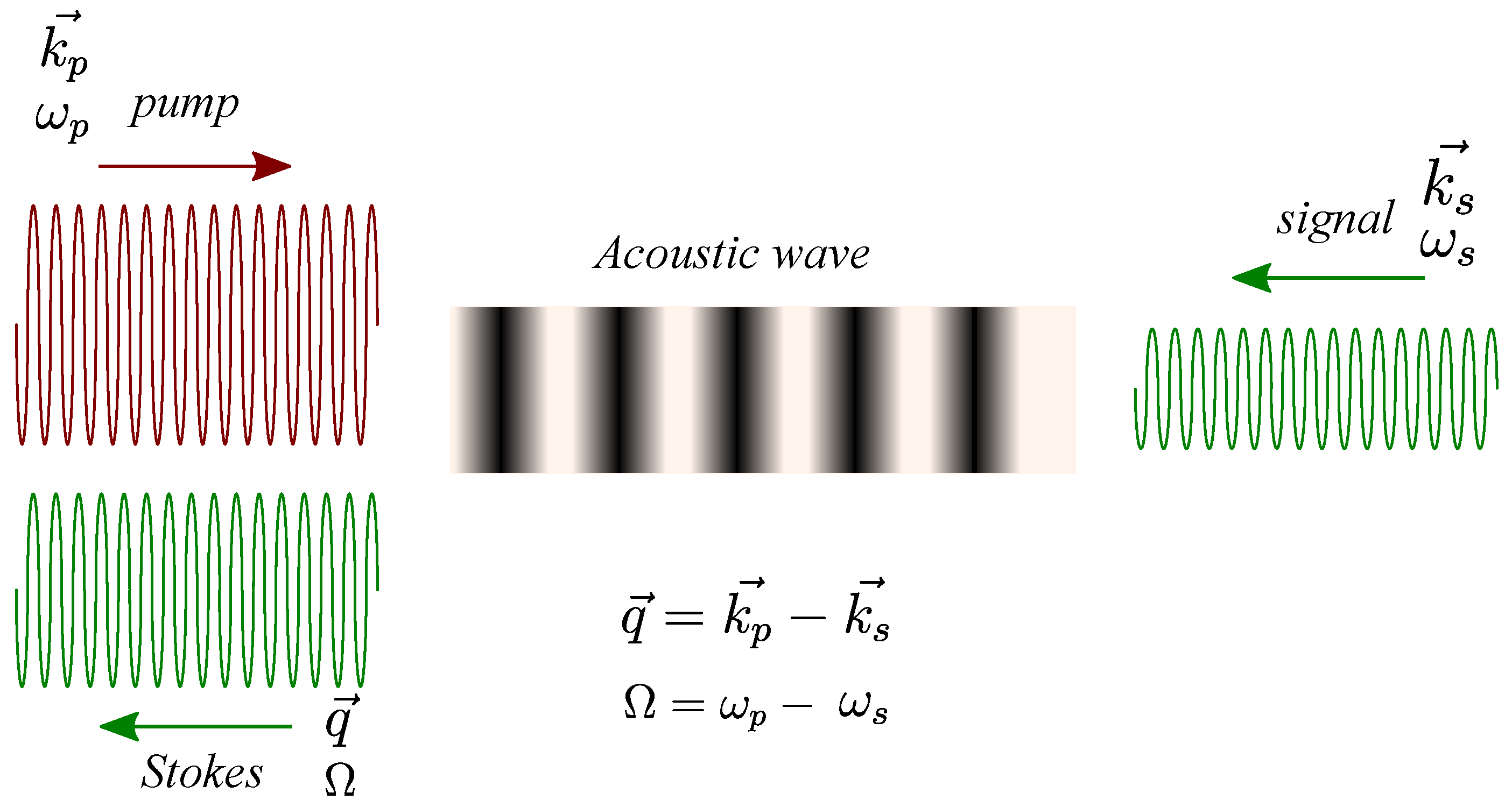
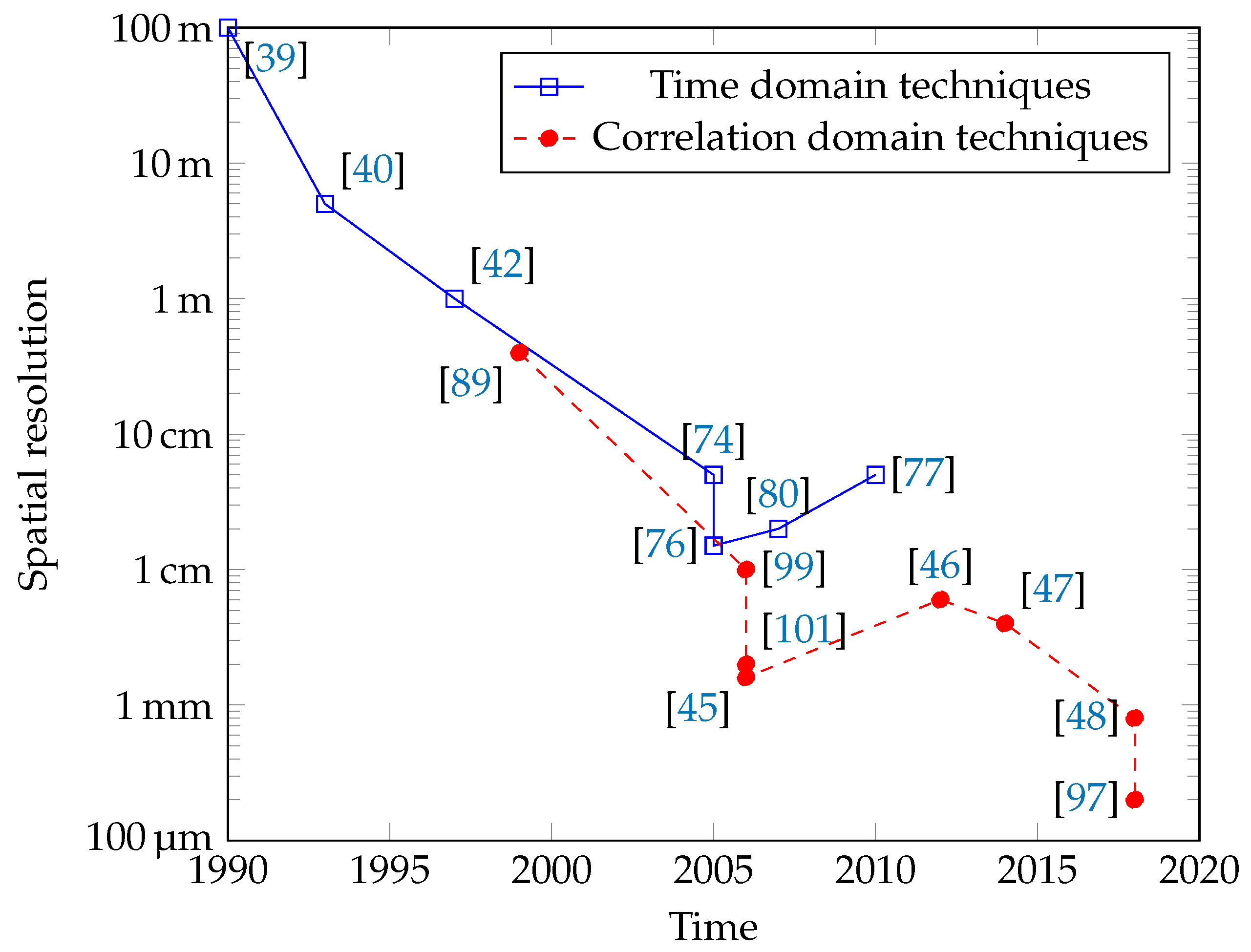


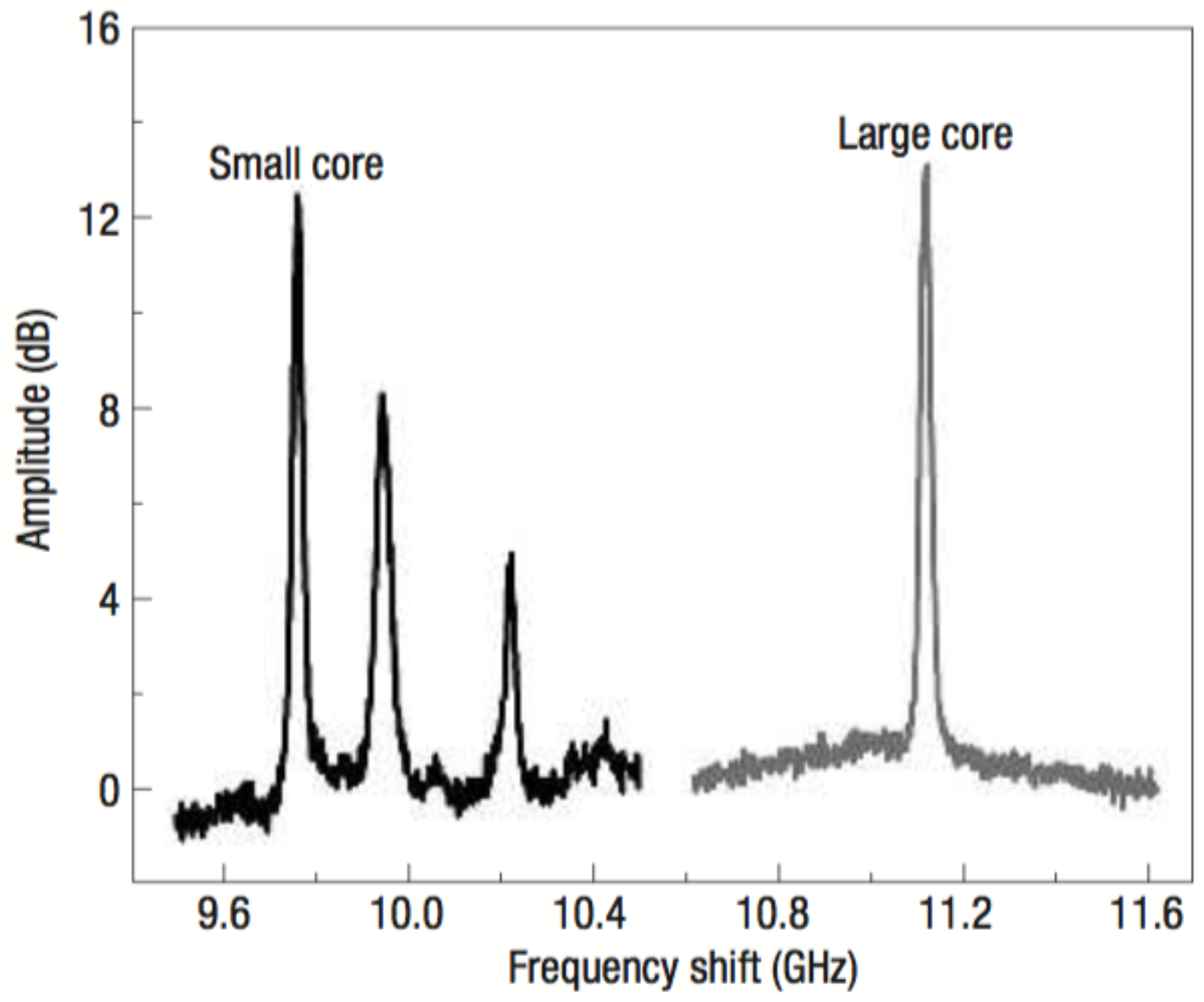

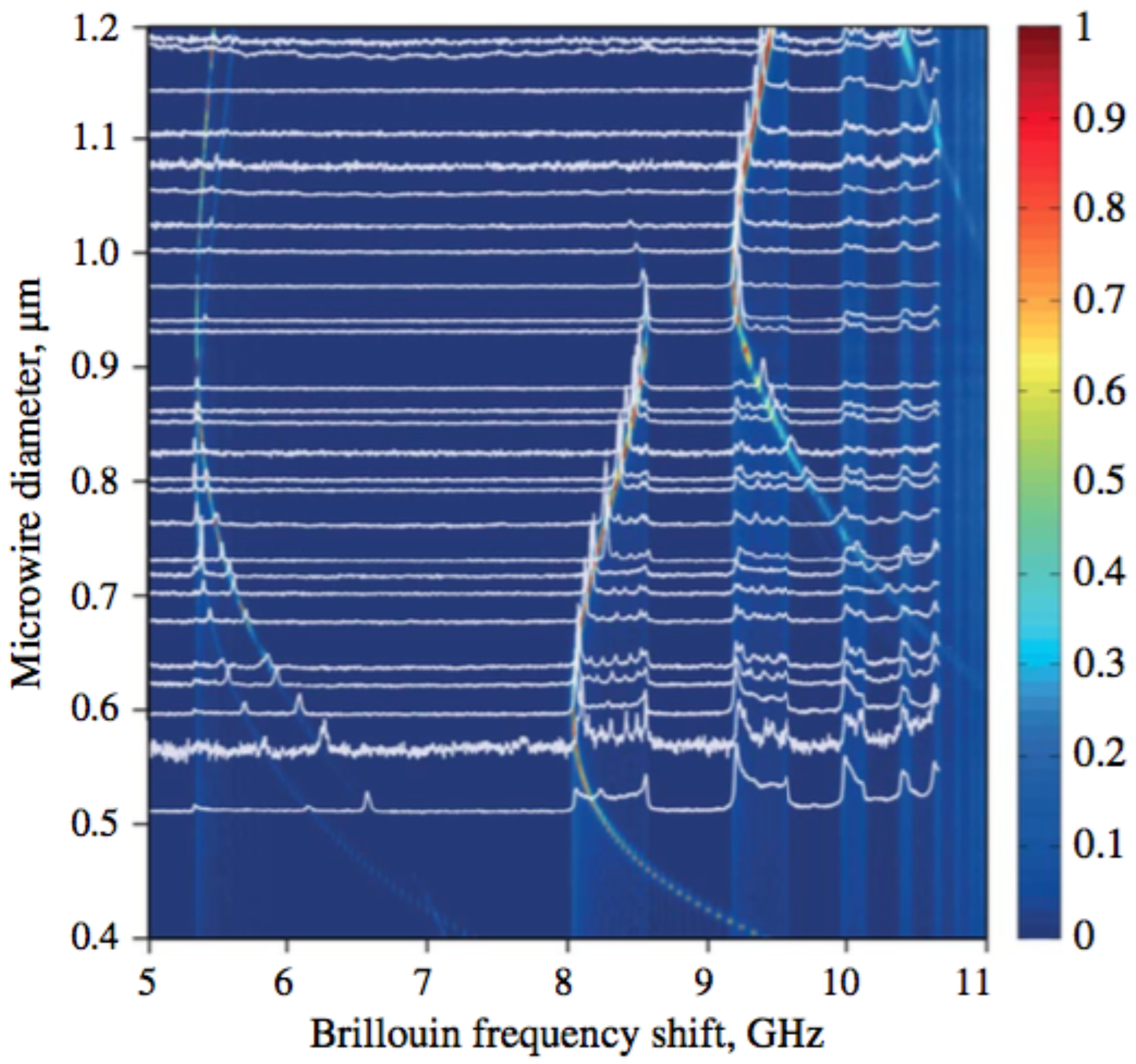




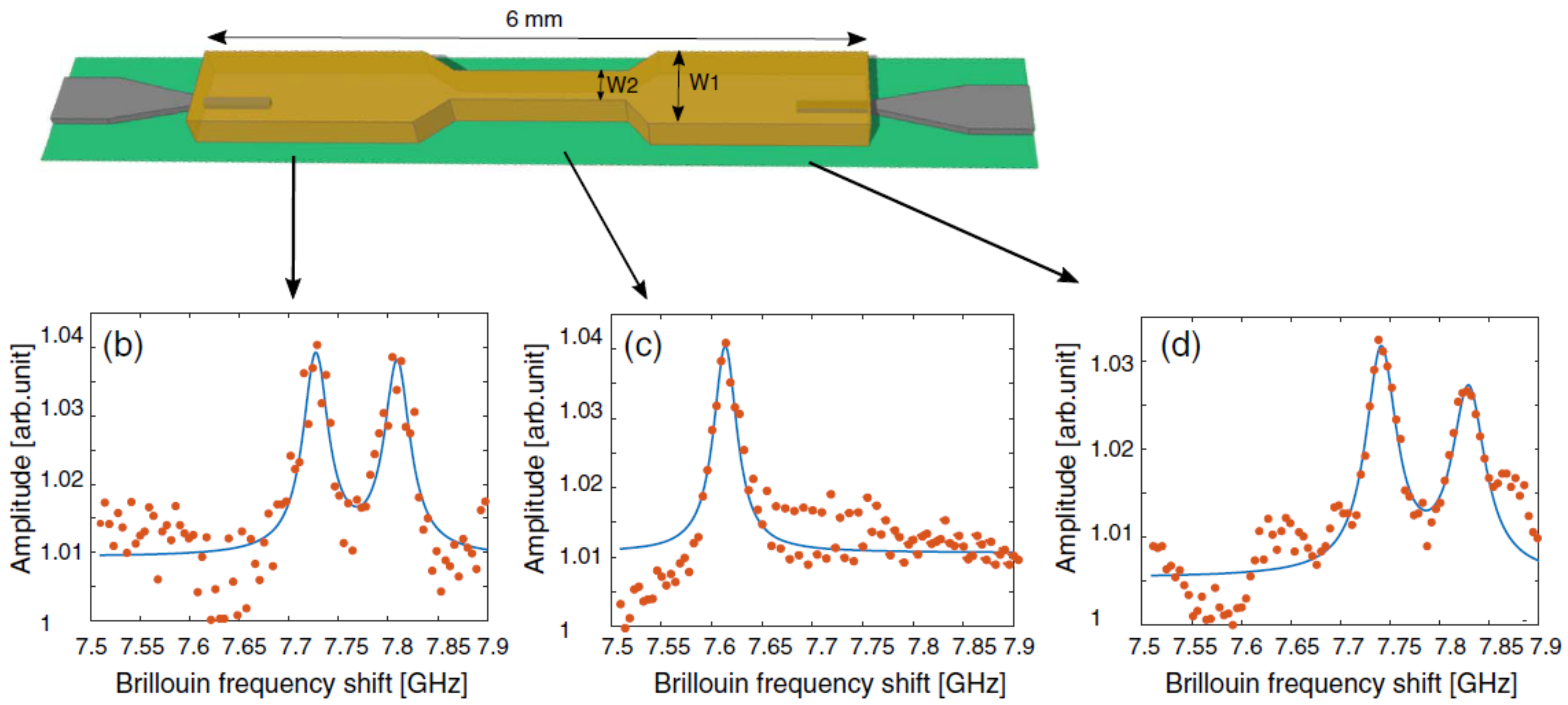

| Spatial Resolution | Technique | Ref. | Platform |
|---|---|---|---|
| 40 cm | FM | [89] | optical fibre |
| 10 cm | FM | [98] | optical fibre |
| 5 cm | Random laser | [90] | optical fibre |
| 3 cm | Random-phase code | [50] | microwire |
| 1 cm | FM | [99] | optical fibre |
| 1 cm | Random-phase code | [44,100] | optical fibre, microwire |
| 6 mm | FM | [46] | silica planar waveguide |
| 4 mm | ASE | [47] | optical fibre |
| 2 mm | FM | [101] | optical fibre |
| 1.6 mm | FM | [45] | optical fibre |
| 800 | ASE | [48] | on-chip waveguide |
| 200 * | ASE | [97] | on-chip waveguide |
© 2018 by the authors. Licensee MDPI, Basel, Switzerland. This article is an open access article distributed under the terms and conditions of the Creative Commons Attribution (CC BY) license (http://creativecommons.org/licenses/by/4.0/).
Share and Cite
Zarifi, A.; Stiller, B.; Merklein, M.; Eggleton, B.J. High Resolution Brillouin Sensing of Micro-Scale Structures. Appl. Sci. 2018, 8, 2572. https://doi.org/10.3390/app8122572
Zarifi A, Stiller B, Merklein M, Eggleton BJ. High Resolution Brillouin Sensing of Micro-Scale Structures. Applied Sciences. 2018; 8(12):2572. https://doi.org/10.3390/app8122572
Chicago/Turabian StyleZarifi, Atiyeh, Birgit Stiller, Moritz Merklein, and Benjamin J. Eggleton. 2018. "High Resolution Brillouin Sensing of Micro-Scale Structures" Applied Sciences 8, no. 12: 2572. https://doi.org/10.3390/app8122572





